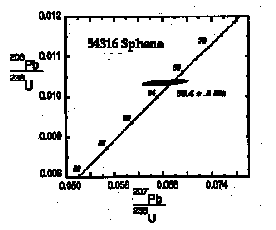
Isotopic ages that can be unambiguously tied to specific stages in the metamorphic evolution of the Alps are still sparse and have been obtained on rare, especially favourable rocks. In an attempt to expand the range of robustly dateable material we have investigated the suitability of U-bearing minerals in low to medium grade metasediments for dating metamorphic crystallisation. Sphene (titanite) is widespread in calc schists and the reactions controlling its behaviour are beginning to be understood. In pelites on the other hand allanite can be a significant mineral and we have found examples where allanite porphyroblasts have classic inclusion fabrics which allow its growth to be tied to the general fabric development.
In sphene U concentrations vary unpredictably between 0.5 and 250 ppm and some samples have U/Pb ratios which are sufficiently high to yield concordant ages with errors on the 238U-206Pb age below 1Ma. Other lithologically similar samples have much lower U/Pb ratios and some have developed negligible radiogenic enrichment since Alpine metamorphism. Monometamorphic rocks have produced precise dates for high pressure metamorphism in the Sesia Zone (Figure 1). However metamorphic temperatures which reached 550°C were insufficient to cause complete resetting of the U-Pb system in sphene (f ~ 150-270 µm) from poly-metamorphic rocks. This confirms the refractory behaviour of U-Pb isotopes in sphene but further complicates the selection of samples that will produce reliable metamorphic ages. For this reason the recognition of rocks which were not metamorphosed until Alpine times is crucial in obtaining reliable ages for the high pressure event.
Allanite generally has high concentrations of uranium (ranging from 80-600ppm) but samples suitable for precise dating are limited by variable, often very high initial lead concentrations (up to 3000ppm!) in contrast to igneous allanites (e.g. von Blankenburg, 1992). Allanites from two pelite samples from the Tauern Window yielded precise ages (Inger and Cliff, 1994), in one case 12±2 Ma older than the Rb-Sr age of co-existing white mica. This suggests that allanite may preserve ages relating to the prograde parts of metamorphic PT-paths.
Experience shows that dating metamorphism using sphene and allanite in metasediments remains a hit and miss affair with excellent results in a small proportion of samples. The search continues for simple petrographic criteria that would facilitate more efficient sample section.
Inger, S. & Cliff, R.A., J. Metamorph. Geol. 12, 695-707 (1994).
von Blanckenburg, F., Chem. Geol. 100, 19-40 (1992). 